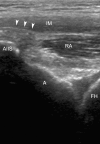Case report: calcific tendinitis of the rectus femoris: a rare cause of snapping hip
- PMID: 20054675
- PMCID: PMC3049605
- DOI: 10.1007/s11999-009-1208-9
Case report: calcific tendinitis of the rectus femoris: a rare cause of snapping hip
Abstract
Background: Internal snapping hip is a syndrome caused by recurrent subluxation of the iliopsoas tendon. There is little agreement regarding the impinging sites responsible for the jerky motion of the tendon. Thus far, the lesser trochanter, anterior capsule, and iliopectineal eminence are considered the most likely catching sites.
Case description: We report an unusual case in which a calcific tendinitis of the rectus femoris direct head impinged against the overlying iliacus muscle, resulting in a painful coxa saltans. The exclusive involvement of the direct head hid the calcium deposit on standard radiographs, whereas MRI suggested but poorly showed the tendon disease. Dynamic ultrasonography and CT scanning allowed a precise diagnosis and subsequent treatment with CT-guided steroid injection.
Literature review: Calcific tendinitis of the rectus anterior direct head has not been reported as a possible cause of snapping hip; involvement of the direct head in rectus anterior calcific tendinitis was described in one case.
Purposes and clinical relevance: Our case shows the rectus anterior direct head may be involved in the etiology of coxa saltans. Theoretically any thickening of the tendon might activate the same pathomechanism. Physicians should consider this possible new cause of internal snapping hip when the most common ones have been excluded, especially as it may be managed easily with steroid injection.
Figures





Similar articles
-
Endoscopic treatment of calcific tendinitis of the rectus femoris in a patient with intractable pain.J Orthop Sci. 2013 Nov;18(6):1046-9. doi: 10.1007/s00776-012-0250-8. Epub 2012 Jul 4. J Orthop Sci. 2013. PMID: 22760698 No abstract available.
-
Acute calcific tendinitis of the rectus femoris associated with intraosseous involvement: a case report with serial CT and MRI findings.Eur J Orthop Surg Traumatol. 2013 Nov;23 Suppl 2:S233-9. doi: 10.1007/s00590-012-1156-z. Epub 2012 Dec 30. Eur J Orthop Surg Traumatol. 2013. PMID: 23412277 Review.
-
The snapping hip: clinical and imaging findings in transient subluxation of the iliopsoas tendon.Can Assoc Radiol J. 1996 Jun;47(3):202-8. Can Assoc Radiol J. 1996. PMID: 8640418
-
Arthroscopic treatment of chronically painful calcific tendinitis of the rectus femoris.Eur J Med Res. 2013 Nov 23;18(1):49. doi: 10.1186/2047-783X-18-49. Eur J Med Res. 2013. PMID: 24266900 Free PMC article.
-
Case report: Bifid iliopsoas tendon causing refractory internal snapping hip.Clin Orthop Relat Res. 2011 Jan;469(1):289-93. doi: 10.1007/s11999-010-1452-z. Epub 2010 Jul 1. Clin Orthop Relat Res. 2011. PMID: 20593254 Free PMC article. Review.
Cited by
-
Case report and presentation of a new classification system for hip acetabular and periacetabular ossifications and calcifications.SA J Radiol. 2024 May 31;28(1):2874. doi: 10.4102/sajr.v28i1.2874. eCollection 2024. SA J Radiol. 2024. PMID: 38840829 Free PMC article.
-
Uncommon Presentation of Hip Pain Due to Calcific Tendonitis in the Rectus Femoris.J Orthop Case Rep. 2025 Jan;15(1):160-165. doi: 10.13107/jocr.2025.v15.i01.5162. J Orthop Case Rep. 2025. PMID: 39801842 Free PMC article.
-
Hydroxyapatite deposition disease around the hip: outcomes of CT-guided treatment.Diagn Interv Radiol. 2016 Sep-Oct;22(5):466-70. doi: 10.5152/dir.2016.15616. Diagn Interv Radiol. 2016. PMID: 27537854 Free PMC article.
-
Acute Calcific Tendinitis of the Rectus Femoris: A Case Series.J Orthop Case Rep. 2015 Jul-Sep;5(3):32-4. doi: 10.13107/jocr.2250-0685.301. J Orthop Case Rep. 2015. PMID: 27299063 Free PMC article.
-
Rare case of symptomatic calcific tendinopathy of the origin of rectus femoris tendon.BMJ Case Rep. 2020 Dec 13;13(12):e236809. doi: 10.1136/bcr-2020-236809. BMJ Case Rep. 2020. PMID: 33318275 Free PMC article.
References
Publication types
MeSH terms
Substances
LinkOut - more resources
Full Text Sources
Medical

